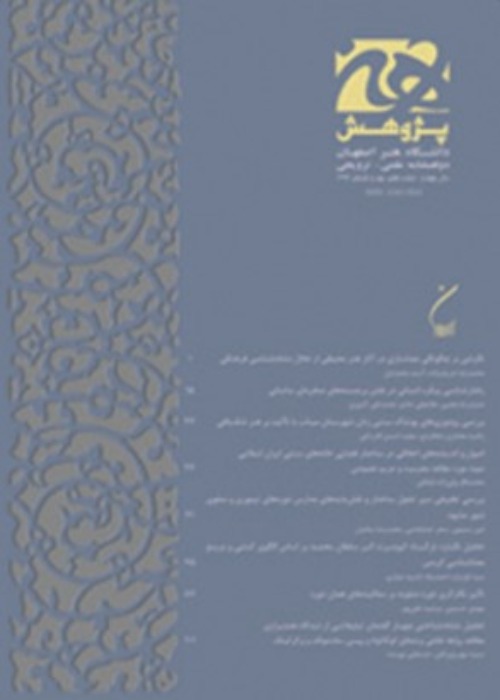Restoration of the Design and Motif of the Textiles in the reign of Fathali Shah Qajar In view of Royal Figurative Paintings
Author(s):
Article Type:
Research/Original Article (ترویجی)
Abstract:
The traditional textile art has passed a path along with the royal figurative paintings of the court, which was dynamic in the first period of the Qajar era, and it went out of progress in the second period, because of the flourishing of naturalism. Despite the boom at the beginning, the traditional textiles found many substitutes with the arrival of industrial fabrics in the middle of the mentioned era. While in the first half of this dynasty concurrent with Fathali Shah’s rule, this art had not been waned, and just like the art of painting in this era, it was leading the competition with the combination of both domestic and foreign arts. The present paper sought to answer this question: How can we try to recognize the design and motif of the common textile of that time by studying the royal figurative Paintings of the reign of Fathali Shah Qajar? The purpose of this article is to identify the design and motif of the common textiles of that time based on the principles of the Iranian traditional arts by the analytical – historical method and by examining seventeen royal figurative paintings of that era. Certainly, because of the fact that the main focus of this research is on the figurative arts, it must be said that the design and motif of the textiles of clothes attract more attention than other applications of textiles. However, the results of this study suggest that in addition to textiles with no design and motif, most of the textiles of that era used the designs of Vagire, Ghabi, Moharamat, and Afshan that were usually decorated with the plant patterns. Among the mentioned designs, the designs of Afshan and Moharamat were more popular among the common people. Afshan design was defined by being used for women clothes and household uses and Moharamat design was the prevalent design in the clothes of the royal servants. On the contrary, various types of textiles without any further design appeared in the wardrobes of the royal family and they were sometimes decorated with Moharamat trimming. Moharamat and Ghabi designs were also widely used in the clothes of men and women of different classes of the society.
Keywords:
Language:
Persian
Published:
Journal of Pazhuhesh-e Honar, Volume:8 Issue: 15, 2018
Pages:
87 to 106
magiran.com/p1904765
دانلود و مطالعه متن این مقاله با یکی از روشهای زیر امکان پذیر است:
اشتراک شخصی
با عضویت و پرداخت آنلاین حق اشتراک یکساله به مبلغ 1,390,000ريال میتوانید 70 عنوان مطلب دانلود کنید!
اشتراک سازمانی
به کتابخانه دانشگاه یا محل کار خود پیشنهاد کنید تا اشتراک سازمانی این پایگاه را برای دسترسی نامحدود همه کاربران به متن مطالب تهیه نمایند!
توجه!
- حق عضویت دریافتی صرف حمایت از نشریات عضو و نگهداری، تکمیل و توسعه مگیران میشود.
- پرداخت حق اشتراک و دانلود مقالات اجازه بازنشر آن در سایر رسانههای چاپی و دیجیتال را به کاربر نمیدهد.
In order to view content subscription is required
Personal subscription
Subscribe magiran.com for 70 € euros via PayPal and download 70 articles during a year.
Organization subscription
Please contact us to subscribe your university or library for unlimited access!



